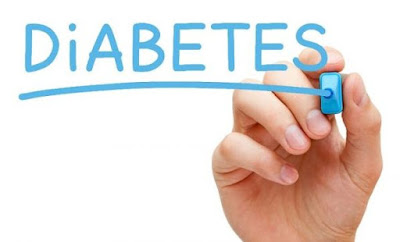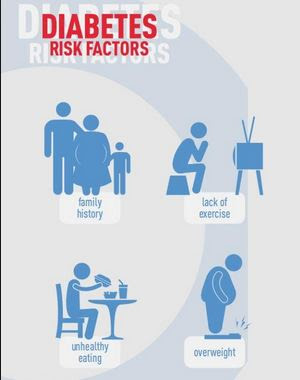Type 2 Diabetes Symptoms, Causes, And Treatment
Wednesday, 27 September 2017
Add Comment
What is type 2 diabetes?
Diabetes mellitus type 2 is a type of diabetes that are
caused by the body not producing enough insulin. Insulin is very important
because it controls the amount of sugar (glucose) cells of the body. As a
result, diabetics have high sugar levels in the blood.
 |
| Type 2 Diabetes Symptoms |
People suffering from diabetes have high blood sugar
levels, but not enough for the body's cells. This condition causes severe
complications of the heart, eyes, kidneys, nervous system, gums and teeth.
How General diabetes type 2?
Type 2 diabetes or diabetes, is the most common type of
diabetes. As much as 95% of cases of diabetes is type 2 diabetes. This disease
can attack in all people in every age, including children. However, type 2 diabetes
usually occurs in adults and the elderly. In addition, people who rarely move
Obesity and have a higher risk of suffering from diabetes.
Signs and symptoms
What are the signs and symptoms of diabetes mellitus
type 2?
Type 2 diabetes patients often do not experience any
symptoms in the early days. They can even do not realize the symptoms for
several years. Some of the symptoms of type 2 diabetes are:
• Opaque Views
• Tired
• Increased hunger
• Increased thirst
• Urinate frequently, especially in the evenings
• The wound that is slow to recover or frequent
infections
• Pain or numbness in the feet and hands
There are some possible signs and symptoms that are not
mentioned above. If you have any further questions about the symptoms, please
contact your doctor.
When should I see a doctor?
If you have any signs or symptoms of the above
mentioned or have any questions, please contact your doctor. Everyone's body
reacts differently.discuss with your doctor to determine which is best for your
circumstances.
What causes type 2 diabetes?
When you have type 2 diabetes, your fat, liver, and
muscle cells don't respond to insulin properly. This is called insulin
resistance. As a result, blood sugar cannot reach the cells to help turn it
into energy. When sugar cannot enter cells, increases in blood sugar levels are
high. This is called hiperglisemik.
The causes of insulin resistance are:
• Overweight or obese: FAT to make the body Increase
the difficulty of using insulin properly.
• Descent: like type 1 diabetes, family medical history
and a gene is also the factors that lead to type 2 diabetes.
The risk factors
The experts don't fully understand why some people
exposed to the risk of diabetes and some not. However, there are some things
that obviously increases the risk of type 2 diabetes, you are exposed, such as:
• Weight. Is excess weight a major risk factor for type
2 diabetes. The thicker the fatty tissues, cells are increasingly resisting
insulin. But it is not just the overweight people who have type 2 diabetes
risk.
• Storage of fat in the body. If your body accumulates
fat on the abdomen, your risk is greater experience than type 2 diabetes if
your body store fat in other parts, such as the hips and thighs.
• Not active. The more you passive, the greater the risk you have type 2 diabetes. Physical activity helps you control your weight, use glucose as energy, and make Your cells more sensitive to insulin.
• A family history. The risk of experiencing more type 2 diabetes if your parents or your siblings have type 2 diabetes.
• Race. Although it remains unclear why, most people of a race - including race black, Hispanic, Asian, Indian, and more likely to have risk against type 2 diabetes than the white race.
• Age. The risk of type 2 diabetes increases as You grow in age, particularly after the age of 45 years. This may be because people in this age tend to be less moving, loss of muscle mass, and gain weight with age. However, type 2 diabetes has also increased dramatically in children, teens, and early adulthood.
• Prediabetes. Prediabetes is a condition in which your blood sugar levels higher than normal, but not high enough to be classified as diabetes. If not resolved, prediabetes can be increased to type 2 diabetes.
• Diabetes, gestational. If you are having gestational diabetes or diabetes while pregnant, the risk of you having type 2 diabetes increases. If you gave birth to a baby that weighed more than 4 pounds, your baby is also at risk of experiencing diabetes type 2.
• Polycystic ovarian syndrome. For women who are having polycystic ovarian syndrome (PCOS) - which is a irregular menstruation, excessive hair growth, and obesity - diabetes risk will increase.
Treatment
What are type 2 diabetes medications often used?
Type 2 diabetes cannot be cured, but can be controlled.
Once you are diagnosed, you can learn what you need to do to stay healthy. Just
needs some changes and commitment to live a healthier lifestyle.
If left untreated, diabetes complications that may
occur are:
• Blindness
• Heart disease
• Kidney disease
• Leg Amputation
Diabetics twice as likely to die compared with those in
the same age who did not suffer from diabetes.
Some types of frequently used treatment for type 2
diabetes:
• Insulin: Insulin is best to control your blood sugar. You can inject insulin at home, usually 2-3 times a day.
• A Healthy Diet: a Healthy Diet will help control Your glucose levels. Diet experts can assist you in putting together a diet.
• Sports: should you often do sport because by moving can control blood sugar levels. In addition, you should also keep Your eyes and check your feet regularly to prevent complications in the future.
What are the usual tests done to diagnose type 2
diabetes?
Diabetes can be diagnosed with a blood test as follows:
• A fasting glucose Test
• Random glucose Test
• Oral glucose Test
• Hemoglobin A1c Test
If you are diagnosed with type 2 diabetes, you should go to the doctor every 3 months, so you can:
• Inspect skin and bones on the soles of the feet and legs.
• Check if Your feet numb.
• Check your blood pressure.
• Examine the back of your eye using a tool with a
special light.
• Completing tests A1C (every 6 months if your diabetes
well controlled)
Tests and examinations will help you and your doctor monitor your diabetes and prevent problems caused by diabetes. In addition, you should perform the following checks once a year:
• Check the level of cholesterol and triglycerides.
• Perform tests once a year ensures your kidneys work
proper (microalbumin and serum creatine).
• Go to the dentist every 6 months for cleaning and
inspection as a whole. Make sure your dentist and health expert You know that
you have diabetes.
Treatment at home
What are the lifestyle changes to address type 2
diabetes mellitus?
The following lifestyle changes can help you cope with
diabetes:
• Keep your blood sugar levels normal
• Exercise and eat regularly
• Try to have a normal body weight
• Eat a healthy diet: fibrous food, vegetable, fruit,
low fat, low sugar, and foods with white flour.
• Go to the eye doctor every year and the dentist twice
a year
• Call your doctor if you cannot eat or drink due to
vomiting
• Call your doctor if your blood sugar level suddenly
is not normal
• Do not smoke


0 Response to "Type 2 Diabetes Symptoms, Causes, And Treatment"
Post a Comment